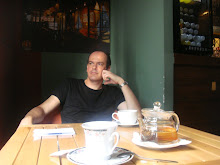“For nearly twelve years prior to the outbreak of World War II, I had been engaged upon the special project of studying and translating the religious texts of the Na-khi [or Naxi] tribe of northwest Yünnan. When it became impossible for me to stay in Likiang for economic reasons, I gathered my material and shipped it from Calcutta on the S.S. Richard Hovey to the United States. This ship was sunk in 1944 by the Japanese and all my work was lost. I then determined to return to China to do the work over again.”
These words are taken from an autobiographical note, signed by Joseph Rock as can be found on the website of the Hunt Institute for Botanical Documentation. It feels futile to not be able to push your bike a few more kilometers further uphill, to where Rock had his "cabin" in the long years that he spent in the region of Lijiang, investigating the local flora, culture, language and geography. We were headed for a meeting with history and the remnants of one of it's lesser known "monstres sacrées", and all I can say is ... we just ran out of breath. What a defeat !
My attention was first drawn by the numerous black & white photographs that adorn the walls of the Dongba Palace on Dongdajie (东大街) in Lijiang, just opposite of the better known concert hall where Xuan Ke and his troupe perform nightly chinese traditional Han music. They're hung up in the normal Chinese ramshackle sort-of-way, but they display an obvious quality with respect to their subject. In each subsequent visit to a museum or a temple in Lijiang's surroundings, we would keep running into more of those pictures, very much focusing on the people and their rites as performed by the local shamans known as Dongba's. It struck me that Rock had documented the entire area more than half a century before tourism ever became aware of a place called Lijiang.
 Joseph Francis Rock, born in Vienna in 1884 and deceased in Honolulu 1962, in my view is as close to the idea of the "homo universalis", by which we tend to denominate the likes of Da Vinci, as it gets in modern times . Science and technology has become so specified, one is bound to narrow it's focus to a very specific area of research if one wants to be noticed. This Austrian, who migrated to the United States (Hawaii) in 1907, has left us with valuable contributions and a compendium of work encompassing the fields of botanics, ethnology, geography, linguistics and photography.
Joseph Francis Rock, born in Vienna in 1884 and deceased in Honolulu 1962, in my view is as close to the idea of the "homo universalis", by which we tend to denominate the likes of Da Vinci, as it gets in modern times . Science and technology has become so specified, one is bound to narrow it's focus to a very specific area of research if one wants to be noticed. This Austrian, who migrated to the United States (Hawaii) in 1907, has left us with valuable contributions and a compendium of work encompassing the fields of botanics, ethnology, geography, linguistics and photography.On a sidenote one could ask: has it got to do with Austria, or is it the presence of the mountains that has brought about such men, since somewhat later than Rock, there was also Heinrich Harrer, caught up in the same part of the world, on the roof of the world finding himself teaching the then still young Dalai Lama during his seven year stay in Tibet. Harrer, though with a less unbespoken background than Rock (he joined the Waffen SS in the late 30's), displayed the same breadth of interest.
It is difficult to overestimate the value of Rock's work, it seems to me. Apart from the photographs which he took and of which a good deal can be found via this site, Rock also set out, in cooperation with the Dongba Shamans on the translation of a large body of works in the Naxi manuscript, now being held by the Library of Congress:
The Naxi language is the only pictographic writing system still in use today. The Dongbas created two scripts for ceremonies--pictographic and syllabic (phonetic). Many of the individual symbols, totaling 276 sound complexes, are compounds and are read as a phrase in which verbs and other parts of speech are supplied from memory. In addition, the Naxi language has four tones; each sound complex has many different meanings based on its tone. The Dongba language is influenced by the Tibetan-Burman language family and the tonal and symbolic aspects of Chinese.
During his more than 20 year stay in the region, Joseph Rock produced two histories of the Naxi's as well as a dictionary of over 1000 pages.
One could wonder what would be our knowledge of Naxi culture and language had there been no Joseph Rock. I have no idea how Lijiang fared under the hysteria of the Cultural Revolution, how it's unique script was perceived by the revolutionary zealots, but I can imagine it would have very likely been branded superstitious or bourgeois and I believe a lot of valuable works must have ended their life on one of those bonfires that stood symbol for the erratic ways of the human mind. The omnipresence of Rock's photo's in today's Lijiang proves to me that what this tuberculosis sufferer has brought about in his lifetime, still resounds with vigour and value for today.
Therefore, it is with big respect that I put the nickname as he liked to use it among friends at the top of this article. "Pohaku" is the Hawaiian word for "rock".








No comments:
Post a Comment